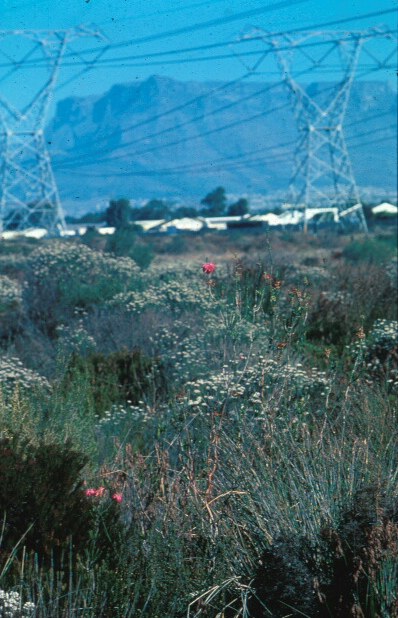
Home
Mission
Overview of Project
Project Staff
Sponsors
Achievements
Checking, Illustrations
Upcoming Activities
Id and Species Lists
Protea Information
Protea Gallery
Growing Proteas
Interim Dist. Maps
Publications
Afrikaanse Inligting
![]()
ESCOM Razes first Natural Heritage Site
 ESCOM has bush cut the first
Natural Heritage Site (NHS) proclaimed in South Africa. It appears that contrary to
agreements and the opinion of the Plattekloof NHS advisory committee, ESCOM unilaterally
decided to bush cut large areas of the 73 ha NHS.
ESCOM has bush cut the first
Natural Heritage Site (NHS) proclaimed in South Africa. It appears that contrary to
agreements and the opinion of the Plattekloof NHS advisory committee, ESCOM unilaterally
decided to bush cut large areas of the 73 ha NHS.
This is a disaster as the area is one of the Core Conservation sites in the Cape Flats (as identified by the Botanical Society’s survey of the Greater Cape Town Metropolitan Area [GCTMA]). From the protea point of view, the following species are severely affected:
Serruria aemula. This is the only effective conservation site for this species. It does occur in a few other places, but other than the N1-N7 interchange (which has no conservation status at present – National Roads can convert this to a new lane or detour if required) and 6BOD (also a NHS, but currently heavily invaded with aliens and without a viable population), this is the only place in the world where it can be conserved. It is considered Endangered and under the new Red Data List catagorization will be Critically Endangered. Two thirds of the population of this species in the NHS may have been eliminated by the mowing.
Diastella proteoides. This was the only viable population of this species left in the GCTMA other than the Tokai population. The mowing has reduced this from a viable population to less than 50 plants. This is also Endangered.
 Leucadendron levisanus. This
species occurs at Kenilworth and Milnerton Race Courses, and at the N1/N7 interchange, but
the Platteklof NHS was one of the last remaining viable conservation areas for this
Endangered species in the GCTMA. Two stands of this species have been mowed, leaving only
one stand intact. Fortunately, one of the mowed stands still contains a few flattened but
not dead individuals.
Leucadendron levisanus. This
species occurs at Kenilworth and Milnerton Race Courses, and at the N1/N7 interchange, but
the Platteklof NHS was one of the last remaining viable conservation areas for this
Endangered species in the GCTMA. Two stands of this species have been mowed, leaving only
one stand intact. Fortunately, one of the mowed stands still contains a few flattened but
not dead individuals.
There are other (non-protea) Red Data Book species that have been severely affected by the mowing. What is disappointing is that ESCOM has been allowed to get away with this destruction. At the very least the NHS status of the site should have been removed. The problem with such a move is then - how do we conserve these species? ESCOM seems to believe that the 50 ha were not included in the NHS – but it has put large signs next to these "excluded" areas proclaiming them as NHS #1! But conservation authorities, NGO’s and the NHS advisory/management committee all seem to believe that ESCOM has in the past agreed to conserve the entire area – in fact, the small core is far too small for effective conservation – it cannot support viable plant populations.
ESCOM argues that fires cannot be allowed under the power lines, because this would cause "dips" in electric transmission. However, hundreds of kilometres of ESCOM lines run through Fynbos, and each patch burns every 10-20 years. Furthermore, Fynbos fires do not generate enough smoke to cause serious spikes. Part of the problem is the totally inadequate alien control within the NHS – there is a very healthy population of Port Jackson Wattles. In fact, the alien hacking ESCOM does do is only effective in killing the biocontrol agent!
Fortunately not all is lost. Hopefully the seed banks are still intact. With effective restoration ESCOM can still undo the damage it has wrought. Unfortunately though, species like Ld levi with its serotinous seeds will need to be resown from live plants. We have spread the cones from the dead remains of the mowed plants around the original populations, but it will take a few seasons to see if the seeds have survived, will germinate and establish.
Although ESCOM deserves all the criticism over its inept management of the NHS, this is not purely an ESCOM problem. It is symptomatic of conservation within GCTMA. Until municipal officers are happy to burn veld there is no conservation future for Fynbos on the Cape Flats (thank heavens the National Parks running the Cape Peninsula appreciate that the mountains need to and will burn). We need some drastic action to galvanise an effective conservation strategy in the GCTMA. Mismanagement of our Fynbos remnants has to stop.
Already we have lost two protea taxa within Cape Town over the past 20 years. Unless we act soon, we will loose a lot more!
ESCOM lead with the proclamation of the first Natural Heritage Site in the country. Let’s see if ESCOM can ‘blaze’ again and show us how to effectively manage our urban Fynbos.
Back PAN 52